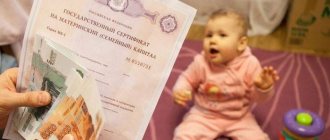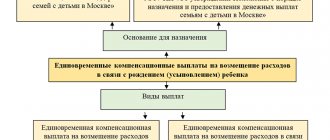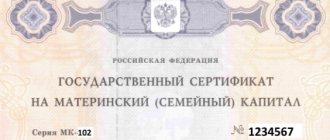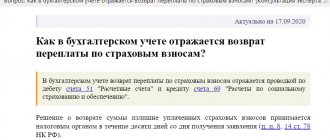Benefits and compensation
Denis Pokshan
Expert in taxes, accounting and personnel records
Current as of December 13, 2017
On January 1, 2021, Federal Law No. 418-FZ dated December 28, 2017 “On monthly payments to families with children” came into force, providing for payments for the first and second child in the family. These payments have already received the unofficial name “Putin benefits”, since their introduction in 2021 was announced by Russian President V. Putin. Who is eligible to receive new monthly child benefits? Where and what documents should I submit? Will employers be required to pay new child benefits? Are family income taken into account when deciding whether to assign new payments for the first and second child? Let's figure it out.
Usual child benefits in 2021
There are so-called basic “children’s” benefits associated with the birth of a child. From February 1, 2021, they will be indexed by a factor of 1.025 Resolution of the Government of the Russian Federation dated January 26, 2018 No. 74 “On approval of the amount of indexation of payments, benefits and compensation in 2021”). Here is a table with the amounts of child benefits from February 1, 2021.
| Type of benefit | Benefit amount | |
| until February 1, 2021 | from February 1, 2021 | |
| One-time benefit for the birth of a child | 16 350,33 | 16 759,09 |
| Minimum monthly allowance for caring for the first child | 3065.69 (including the minimum wage - 3120) | 3795,60 |
| Minimum monthly allowance for caring for the second and subsequent children | 6131,37 | 6284,65 |
| One-time benefit for registration in the early stages of pregnancy | 613,14 | 628,47 |
The listed types of child benefits are financed from the Social Insurance Fund. However, employees can apply to their employers to appoint them.
Legal basis
The calculation and provision of benefits is regulated by the regulatory framework developed by the state to support families with children.
These include Law No. 81-FZ “On State Benefits for Citizens with Children” dated May 19, 1995.”
Order No. 1012N “On approval of the Procedure and conditions for the appointment and payment of state benefits to citizens with children” dated December 23, 2009 also regulates the requirements for recipients of payments.
Two new payments for children from 2021
On November 28, 2021, V. Putin, at a meeting of the Coordination Council for the implementation of the National Strategy for Action in the Interests of Children, proposed introducing completely new monthly payments to young families starting in 2021. For these purposes, the Federal Law “On Monthly Payments to Families with Children” was adopted, providing for two new “children’s” payments: for the first and second child.
| № | Pay | Source of financing |
| 1 | For the first child | federal budget |
| 2 | For a second child | maternity capital funds |
Thus, upon the birth of the first child, the payment will be financed from the state budget. And for the second child, you can receive monthly payments from your own maternity capital. Payments will be possible until the child reaches one and a half (1.5) years of age.
The fundamental question was whether maternity capital would be extended after 2021? Vladimir Putin gave the answer to this question in November 2021 - maternity capital will be extended until December 31, 2021.
In 2021, the amount of maternal (family) capital will remain at the same level and amount to 453,026.0 rubles .
Starting from 2018, some families will be able to receive money from maternity capital in the form of monthly payments for their second child. And maternity capital, accordingly, will decrease.
New calculation of sick leave not lower than the minimum wage
From April 1 to December 31, 2021, there is a special procedure for calculating payments on a certificate of incapacity for work - no less than the minimum wage. The employer is temporarily obliged to pay social benefits in the amount of at least 12,130 rubles (Article 1 104-FZ of 04/01/2020). Here's how to correctly calculate such a payment:
- We determine the average daily earnings (ADE).
- We calculate the amount of daily social benefits taking into account the social security and length of service.
- We display the daily sick leave amount for the month based on the minimum wage. All employee rates and district rates apply.
- We compare all the obtained values. We choose the largest amount.
- We calculate the payment based on the certificate of incapacity for work. To do this, multiply the selected value (from step 4) and the number of days of illness.
The accountant will have to perform a number of new actions: calculate the daily value according to the minimum wage and compare the resulting value with the amount that is due in the usual calculation of sick leave payments.
Amount of new payments for children
The amount of the monthly payment will be equal to the cost of living for children established in the constituent entity of the Russian Federation for the second quarter of the year preceding the year of application for payment. Thus, if you apply for benefits in 2021, the monthly payment will be equal to the cost of living for the 2nd quarter of 2017 in a specific constituent entity of the Russian Federation.
The average all-Russian monthly payment for the first and second child will be:
| In 2021 | RUB 10,523 |
| In 2021 | RUB 10,836 |
| In 2021 | RUR 11,143 |
However, we repeat that the exact amount of the payment depends on the specific region and may differ from the national average. Here is a table of the exact amounts of monthly payments for the first and second child in 2021, broken down by region.
The size of the regional cost of living per child for the 2nd quarter of 2021
| Name of the federal subject (region) | Size of monthly allowance per child for the 2nd quarter of 2021, rub. | What document is it established (number of the Government Resolution) |
| Chukotka Autonomous Okrug | 22222 | 07/24/2017 No. 292 |
| Nenets Autonomous Okrug | 21973 | 07/20/2017 No. 233-p |
| Kamchatka Krai | 21124 | July 25, 2017 No. 301-P |
| Magadan Region | 19073 | 07/19/2017 No. 142-p |
| The Republic of Sakha (Yakutia) | 17023 | 08/28/2017 No. 289 |
| Yamalo-Nenets Autonomous Okrug | 15897 | 08/10/2017 No. 805-P |
| Murmansk region | 15048 | 08/01/2017 No. 387-PP |
| Sakhalin region | 14734 | 08/04/2017 No. 360 |
| g.f.z. Moscow | 14252 | 09/12/2017 No. 663-PP |
| Khanty-Mansiysk Autonomous Okrug - Ugra | 13958 | 07/28/2017 No. 288-p |
| Primorsky Krai | 13553 | 07/31/2017 No. 307-pa |
| Khabarovsk region | 13386 | 08/10/2017 No. 91 |
| Jewish Autonomous Region | 13327,12 | July 17, 2017 No. 68-OD |
| Republic of Kabardino-Balkaria | 12778 | 09/19/2017 No. 170-PP |
| Komi Republic | 12487 | 07/20/2017 No. 395 |
| Krasnoyarsk region | 12020 | 07/18/2017 No. 403-p |
| Amur region | 11979 | 04.09.2017 No. 188 |
| Republic of Karelia | 11978 | 08/17/2017 No. 282-P |
| Arhangelsk region | 11734 | July 27, 2017 No. 288-pp |
| Novosibirsk region | 11545 | 07/14/2017 No. 138 |
| Moscow region | 11522 | 09/27/2017 No. 806/34 |
| Transbaikal region | 11362,79 | 08/07/2017 No. 322 |
| Tomsk region | 11251 | 07/31/2017 No. 174-r |
| g.f.z. Sevastopol | 10935 | 08/17/2017 No. 597-PP |
| Tyumen region | 10832 | 07/31/2017 No. 382-p |
| Vologda Region | 10732 | 08/14/2017 No. 722 |
| Pskov region | 10652 | 08/02/2017 No. 324 |
| Tver region | 10625 | 08/25/2017 No. 261-pp |
| Rostov region | 10501 | 07/26/2017 No. 520 |
| Republic of Crimea | 10487 | 08/18/2017 No. 414 |
| Irkutsk region | 10390 | 07/28/2017 No. 495-pp |
| Astrakhan region | 10382 | July 25, 2017 No. 251-P |
| g.f.z. Saint Petersburg | 10367,9 | 08/17/2017 No. 693 |
| Tyva Republic | 10347 | 08/11/2017 No. 360 |
| Perm region | 10289 | 08/29/2017 No. 756-p |
| The Republic of Buryatia | 10270 | 08/16/2017 No. 405 |
| Chelyabinsk region | 10221 | 07/26/2017 No. 148 |
| Kurgan region | 10217 | 07/25/2017 No. 249 |
| Sverdlovsk region | 10210 | 03/14/2017 No. 152-PP |
| Smolensk region | 10201 | 07/13/2017 No. 470 |
| Novgorod region | 10176 | 07/14/2017 No. 213-rg |
| Kaliningrad region | 10138 | 08/18/2017 No. 439 |
| Ivanovo region | 9999 | 07/18/2017 No. 137-ug |
| Samara Region | 9967 | 07/26/2017 No. 491 |
| Altai Republic | 9954 | 07/24/2017 No. 173 |
| Kemerovo region | 9857 | 07/18/2017 No. 377 |
| Krasnodar region | 9845 | 07/31/2017 No. 1096 |
| Ulyanovsk region | 9818 | 08/25/2017 No. 415-P |
| The Republic of Khakassia | 9811 | 08/14/2017 No. 412 |
| The Republic of Dagestan | 9774 | 08/14/2017 No. 174 |
| Vladimir region | 9752 | 08/02/2017 No. 625 |
| Bryansk region | 9677 | 07/24/2017 No. 338-p |
| Volgograd region | 9664 | 08.08.2017 No. 414-p |
| Kirov region | 9662 | 08/24/2017 No. 417-P |
| Chechen Republic | 9650 | 09/05/2017 No. 195 |
| Mari El Republic | 9645 | 07/21/2017 No. 305 |
| Nizhny Novgorod Region | 9612 | 07/24/2017 No. 547 |
| Kostroma region | 9566 | 08/07/2017 No. 294-a |
| Yaroslavl region | 9547 | 07/14/2017 No. 238 |
| Kaluga region | 9487 | 08/29/2017 No. 479 |
| Penza region | 9470 | 08/01/2017 No. 367-pP |
| Altai region | 9434 | 09/08/2017 No. 335 |
| Oryol Region | 9429 | 07/21/2017 No. 298 |
| Republic of Karachay-Cherkessia | 9428 | 09/12/2017 No. 238 |
| Republic of North Ossetia-Alania | 9372 | 08/15/2017 No. 314 |
| Republic of Adygea | 9325 | 08/02/2017 No. 133 |
| Omsk region | 9323 | 09/06/2017 No. 251-p |
| Leningrad region | 9259 | 08/10/2017 No. 322 |
| Tula region | 9256 | 07/31/2017 No. 325 |
| The Republic of Ingushetia | 9241 | 09/07/2017 No. 137 |
| Ryazan Oblast | 9215 | 07/26/2017 No. 174 |
| Saratov region | 9159 | 08/21/2017 No. 428-P |
| Stavropol region | 9123 | 08/07/2017 No. 313-p |
| Lipetsk region | 9078 | 07/13/2017 No. 339 |
| Kursk region | 8993 | 07/10/2017 No. 548-pa |
| Republic of Udmurtia | 8964 | 08/23/2017 No. 361 |
| Orenburg region | 8958 | 08/11/2017 No. 589-p |
| Republic of Kalmykia | 8944 | 08/21/2017 No. 284 |
| Chuvash Republic | 8910 | 08/24/2017 No. 325 |
| Republic of Bashkortostan | 8892 | 08/28/2017 No. 391 |
| The Republic of Mordovia | 8714 | 07/20/2017 No. 417 |
| Tambov Region | 8634 | 07/21/2017 No. 696 |
| Republic of Tatarstan | 8490 | 07/28/2017 No. 524 |
| Voronezh region | 8428 | 07/25/2017 No. 588 |
| Belgorod region | 8247 | July 24, 2017 No. 286-pp |
Who will be responsible for assigning and paying new benefits?
If a family applies for new child benefits after January 1, 2021, then they will need to apply for their appointment:
- for payment for the first child - to the district department of social protection of the population (RUSZN) at the applicant’s place of residence;
- for payment for the second child - the territorial division of the Pension Fund (UPFR) at the applicant’s place of residence.
If twins are born, then you will need to adhere to the same principle - submit two different sets of documents to RUSZN and UPFR, respectively. At the same time, keep in mind that documents can be submitted through the MFC. This is directly enshrined in law.
But why did they do this? Why did they provide two different departments for the appointment of “children’s”? The fact is that it is the divisions of the Pension Fund that handle maternity capital. Therefore, in order to spend maternity capital on a second child, you need to contact the UPFR.
Documents for receiving payments for a second child can be submitted to the UPFR simultaneously with documents for obtaining a certificate for maternity capital (clause 7 of Article 2 of the Law).
What does the coming year have in store for us?
- Child benefits will increase due to an increase in the minimum wage to 12 thousand 130 rubles. (this will be followed by an increase in maternity benefits) and annual indexation.
- The list of recipients will become wider, because the requirements for their income level will be lower than last year.
- Not only will the minimum size rise to the level of the minimum wage, but also the maximum. The maximum maternity benefit for 140 days can reach 300 thousand rubles.
- Indexation of child benefits is planned from February 2021. The estimated coefficient will be 1.038.
Who can receive payments: conditions
To obtain the right to receive new payments for children, several conditions must be met:
| Condition |
| Parents (or adoptive parents) are citizens of the Russian Federation and permanently reside on the territory of the Russian Federation. |
| The first or second child must be born or adopted after January 1, 2021. If children were born or adopted earlier (for example, in December 2021), then no payment is due. |
| The family must have low income, not exceeding 1.5 subsistence minimums established in the region for working citizens over the last 12 months per family member. |
| Children should not be fully supported by the state. |
| Citizens (parents or adoptive parents) should not be deprived of parental rights or limited in parental rights. |
How will the family’s financial situation be assessed?
To obtain the right to payments (for the first or second child), the average per capita family income should not exceed 1.5 times the subsistence level of the working-age population of a constituent entity of the Russian Federation for the second quarter of the year preceding the year of application. This is enshrined in paragraph 2 of Article 1 of the Law.
Average per capita family income represents the income received for a certain period of time without taxes, which falls on one family member.
Here is a table with the cost of living values for the 2nd quarter of 2021, broken down by region. In this table, in the column “Average per capita family income in 2021,” we provide the maximum amount of income before which you can become eligible for monthly payments for children.
| Subject | P/M of employees for the 2nd quarter of 2021 | Average per capita family income |
| Belgorod region | 8989 | 13483.5 |
| Bryansk region | 10615 | 15922.5 |
| Vladimir region | 10616 | 15924 |
| Voronezh region | 9292 | 13938 |
| Ivanovo region | 10896 | 16344 |
| Kaluga region | 10390 | 15585 |
| Kostroma region | 10581 | 15871.5 |
| Kursk region | 9725 | 14587.5 |
| Lipetsk region | 9580 | 14370 |
| Moscow region | 13146 | 19719 |
| Oryol Region | 10161 | 15241.5 |
| Ryazan Oblast | 10139 | 15208.5 |
| Smolensk region | 11178 | 16767 |
| Tambov Region | 9433 | 14149.5 |
| Tver region | 11037.7 | 16556.55 |
| Tula region | 10120 | 15180 |
| Yaroslavl region | 10429 | 15643.5 |
| Moscow | 18742 | 28113 |
| Republic of Karelia | 13932 | 20898 |
| Komi Republic | 13276 | 19914 |
| Arhangelsk region | 13022 | 19533 |
| Vologda Region | 11907 | 17860.5 |
| Kaliningrad region | 11361 | 17041.5 |
| Leningrad region | 10047 | 15070.5 |
| Murmansk region | 15185 | 22777.5 |
| Novgorod region | 11190 | 16785 |
| Pskov region | 11798 | 17697 |
| Saint Petersburg | 11830.3 | 17745.45 |
| Nenets Autonomous Okrug | 21844 | 32766 |
| Republic of Adygea | 9837 | 14755.5 |
| Republic of Kalmykia | 9264 | 13896 |
| Krasnodar region | 11141 | 16711.5 |
| Astrakhan region | 10140 | 15210 |
| Volgograd region | 10146 | 15219 |
| Rostov region | 10623 | 15934.5 |
| Republic of Crimea | 10634 | 15951 |
| Sevastopol | 11162 | 16743 |
| The Republic of Dagestan | 9922 | 14883 |
| The Republic of Ingushetia | 9319 | 13978.5 |
| Kabardino-Balkarian Republic | 11925 | 17887.5 |
| Karachay-Cherkess Republic | 9815 | 14722.5 |
| Republic of North Ossetia–Alania | 9911 | 14866.5 |
| Chechen Republic | 9996 | 14994 |
| Stavropol region | 9404 | 14106 |
| Republic of Bashkortostan | 9498 | 14247 |
| Mari El Republic | 10047 | 15070.5 |
| The Republic of Mordovia | 9068 | 13602 |
| Republic of Tatarstan | 9142 | 13713 |
| Udmurt republic | 9468 | 14202 |
| Chuvash Republic | 9330 | 13995 |
| Perm region | 10804 | 16206 |
| Kirov region | 10159 | 15238.5 |
| Nizhny Novgorod Region | 10033 | 15049.5 |
| Orenburg region | 9269 | 13903.5 |
| Penza region | 9771 | 14656.5 |
| Samara Region | 11072 | 16608 |
| Saratov region | 9581 | 14371.5 |
| Ulyanovsk region | 10362 | 15543 |
| Kurgan region | 10428 | 15642 |
| Sverdlovsk region | 10653 | 15979.5 |
| Tyumen region | 11212 | 16818 |
| Chelyabinsk region | 10608 | 15912 |
| Khanty-Mansiysk Autonomous Okrug – Ugra | 15294 | 22941 |
| Yamalo-Nenets Autonomous Okrug | 16751 | 25126.5 |
| Altai Republic | 10200 | 15300 |
| The Republic of Buryatia | 10273 | 15409.5 |
| Tyva Republic | 10168 | 15252 |
| The Republic of Khakassia | 9857 | 14785.5 |
| Altai region | 10002 | 15003 |
| Transbaikal region | 11392.29 | 17088.435 |
| Krasnoyarsk region | 12163 | 18244.5 |
| Irkutsk region | 10814 | 16221 |
| Kemerovo region | 9981 | 14971.5 |
| Novosibirsk region | 11854 | 17781 |
| Omsk region | 9683 | 14524.5 |
| Tomsk region | 11539 | 17308.5 |
| The Republic of Sakha (Yakutia) | 17601 | 26401.5 |
| 1.5 | ||
| Kamchatka Krai | 20399 | 30598.5 |
| Primorsky Krai | 13191 | 19786.5 |
| Khabarovsk region | 13807 | 20710.5 |
| Amur region | 12184 | 18276 |
| Magadan Region | 18994 | 28491 |
| Sakhalin region | 14552 | 21828 |
| Jewish Autonomous Region | 10158.05 | 15237.075 |
| Chukotka Autonomous Okrug | 21396 | 32094 |
Family members and income: who is included and how they are calculated
Let us explain who is included in the family composition taken into account when calculating the average per capita income. (Clause 10 of Article 4 of the Law):
| Family composition | |
| Turn on | Do not turn on |
| Parents of minor children | Persons serving a sentence of imprisonment and persons in custody |
| Spouses of parents | Persons undergoing compulsory treatment by court decision |
| Minor children | Persons deprived of parental rights or limited in parental rights |
But what exactly should be included in income? The answers to these questions are contained in Article 4 of the Law. In the table we summarized family income in cash, which is taken into account when calculating average per capita income.
| What is included in family income |
| Remuneration for the performance of labor or other duties, including compensation and incentive payments. |
| Remuneration for work performed, service provided, action performed in the Russian Federation. (in particular, civil contracts) |
| Remuneration of directors and other similar payments received by members of the management body of an organization (board of directors or other similar body) - a tax resident of the Russian Federation, the place of location (management) of which is the Russian Federation, are considered as income received from sources in the Russian Federation, regardless of the place where actually the management responsibilities assigned to these persons were performed or from where the payments of these remunerations were made |
| Income from business activities (IP) |
| Pensions, benefits, scholarships and other similar payments received by a citizen in accordance with the legislation of the Russian Federation and (or) the legislation of a constituent entity of the Russian Federation or received from a foreign organization in connection with the activities of its separate division in the Russian Federation. |
| Payments to successors of deceased insured persons in cases provided for by the legislation of the Russian Federation on compulsory pension insurance. |
| Compensation paid by a government agency or public association for the performance of government or public duties. |
| Monetary allowances for military personnel, employees of internal affairs bodies of the Russian Federation, institutions and bodies of the criminal executive system, customs authorities of the Russian Federation and other bodies in which the legislation of the Russian Federation provides for federal public service related to law enforcement activities, as well as additional payments of a permanent nature, and food supply (monetary compensation in exchange for food rations), established by the legislation of the Russian Federation. |
Regional specifics
Benefit amounts may vary depending on the region or constituent entity of the Russian Federation. This must be taken into account when applying the current legislation. The difference in amounts will always be in favor of the recipient of compensation; if the region has its own standards, they should be higher (or at least not lower) than federal values.
We are talking about the so-called regional coefficients established for some districts and regions of the Russian Federation. The fixed amounts of compensation listed in the article must be increased by the amount of the specified coefficients; “northern”, “Ural” and other coefficients are applicable to them. Through the use of these indicators established by federal law, compensation will increase, and significantly, in some cases the amount will increase by 15%, and in some regions it will exceed the national value by one and a half or even two times.
Applying for monthly payments: deadlines
You can submit an application for a monthly payment in connection with the birth (adoption) of your first or second child to RUSZN or UPFR at any time within one and a half years from the date of birth of the child.
However, payment will be made from the date of birth of the child if the application is made no later than 6 months from the date of birth of the child. In other cases, the payment will be paid from the day you apply for it. Therefore, don’t delay! You need to have time to submit an application in the first 6 months of the child’s life.
Payments will only be made for one year
The monthly payment in connection with the birth (adoption) of the first or second child is assigned for a period of one year. After this period, the citizen submits a new application for the appointment of the specified payment for the period until the child reaches the age of one and a half years, and also submits the documents (copies of documents, information) necessary for its appointment.
What else you need to know about new monthly payments in 2018
Below in the table we provide additional useful information about the new “Putin” payments in 2021 for the first child or from maternity capital funds:
| The payment will be transferred to your bank account. It will not be possible to receive money in cash. |
| Maternity capital will be reduced monthly by the monthly payment for the second child (if issued). If maternity capital is completely used up, there will be no more payments. |
| The income of each family member is taken into account before taxes in accordance with the legislation of the Russian Federation. |
| Family income in foreign currency is converted into rubles at the exchange rate of the Central Bank of the Russian Federation on the date of receipt of this income. |
| You can refuse to receive payments. Payments will stop on the 1st of the next month. |
If you find an error, please select a piece of text and press Ctrl+Enter.
For pregnancy and childbirth
According to the law, women have the right to receive benefits under the BiR. Its size has different meanings and depends on the social status of the young mother:
| Category | Sum |
| for working people | 100% of average daily earnings for each day of vacation according to BiR |
| for the unemployed | In the amount of previously received unemployment benefits |
| for full-time students | 100% of the scholarship amount per month |
| for wives of military personnel | RUR 26,721.01 |
| for women dismissed no later than 12 months before applying for benefits due to the liquidation of the enterprise | RUB 632.76 |
| for women military personnel under contract | 100% of the monthly allowance |
Minimum amount of maternity payments based on the minimum wage
Calculation of maternity benefits based on the minimum wage occurs in two cases:
- If during the billing period the woman was not employed or her income was extremely low.
- Provided that the woman worked for less than six months before going on labor and employment leave.
In these cases, the payment will be the minimum amount. It is calculated based on the minimum wage, which is revised annually. For 2021, its value is set at 9,489 rubles. The calculation of average earnings in 2021 depends on the number of days in the 2021 and 2021 reporting years. Since 2021 is a leap year, the total amount will be 731 (365+366=731). Then you need to find out the average daily wage. To do this, multiply the minimum wage by the number of months (24) and divide by the number of days. According to the formula - 311 rubles. 54 k./day (9,489*24/731=311.54).
Knowing the daily average, you can calculate the minimum maternity pay:
| Childbirth | Amount of days | Sum | Example calculation |
| Regular | 140 | RUR 43,615 65 k. | 311,54*140=43615,65 |
| Complicated | 156 | RUB 48,600 30 k. | 311,54*156=48 600,30 |
| At the birth of 2 or more children at the same time | 194 | RUB 60,438 83 k. | 311,54*194=60438,83 |
Indexation of the maximum value of the base for calculating insurance contributions to the Social Insurance Fund
Every year, the Russian Government sets the maximum base for the calculation of insurance premiums. From this value the maximum possible amount of maternity payments is calculated. In 2018, for temporary working capacity and maternity, its size was set at 815 thousand rubles. Compared to the previous year, the value was indexed by as much as 8%. To calculate maternity leave in 2018, the following values are taken:
- 2016 – 718 thousand rubles;
- 2017 – 755 thousand rubles.
Limitation of the maximum benefit amount for BiR
There is one small feature that affects the amount of maternity leave. It has a limited size, depending on the maximum size of the base. Even if a woman earns a lot of money, maternity benefits cannot exceed the legally established limit. For the calculation, the maximum base for 2016 and 2021 is taken and divided by the number of calendar days:
(718,000+755,000)/731=2015.05 – maximum average daily earnings. Next, the maximum is calculated based on the type of birth:
minimum maternity pay:
| Childbirth | Amount of days | Sum | Example calculation |
| Regular | 140 | RUB 282,106 70 k. | 2015,05*140=282106,70 |
| Complicated | 156 | RUR 314,347 47 k. | 2015,05*156=314347,47 |
| When 2 or more children are born at the same time | 194 | RUB 390,919 29 k. | 2015,05*194=390919,29 |









